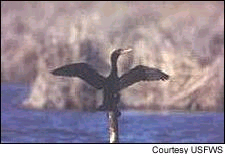forum
library
tutorial
contact

|
the film forum library tutorial contact |

|
Cormorants May Lose in Conflict Over FishEnvironmental News Network - November 26, 2001 |
 The U.S. Fish and Wildlife Service is proposing to hand the management of rapidly growing numbers of fish eating birds known as double-crested cormorants over to individual states and federal agricultural managers.
The U.S. Fish and Wildlife Service is proposing to hand the management of rapidly growing numbers of fish eating birds known as double-crested cormorants over to individual states and federal agricultural managers.
The agency has released a draft Environmental Impact Statement (EIS) for public review that will guide development of a new nationwide management strategy for double-crested cormorants, which can compete with humans for fish.
The EIS analyzes various options for managing the burgeoning cormorant populations to reduce conflicts with recreational anglers, commercial aquaculture and other human activites.
Cormorants have been federally covered by the Migratory Bird Treaty Act since 1972, when they were given protection after their populations dropped due to use of the pesticide DDT, killings by humans and the overall declining health of many ecosystems, especially that of the Great Lakes.
"The double-crested cormorant was given federal protection during serious population declines in the 1970s. Today, we face a different problem as we seek to achieve sustainable populations and reduce conflicts with human activities," said Tom Melius, U.S. Fish and Wildlife Service (USFWS) assistant director for Migratory Birds and State Programs.
Today, the population is at historic highs, due to the presence of ample food in their summer and winter ranges, federal and state protection, and reduced contaminant levels. The population resurgence of double-crested cormorants has led to increasing concern about the birds' impact on commercial and recreational fishery resources.
The majority of research studies conducted around the world have shown that while cormorants can, and often do, take fish species that are valued in commercial and sport fisheries, those species make up a small proportion of the birds' diet.
The draft EIS evaluates six management alternatives, including such options as continuing current management practices, implementing only non-lethal management techniques, establishing frameworks for a cormorant hunting season, or issuing a new Depredation Order to address public resource conflicts which is the alternative favored by the Fish and Wildlife Service.
In 1998, the Service issued a Depredation Order authorizing commercial freshwater aquaculture producers in 13 states -- Alabama, Arkansas, Florida, Georgia, Kentucky, Louisiana, Minnesota, Mississippi, North Carolina, Oklahoma, South Carolina, Tennessee, and Texas -- to kill double-crested cormorants, without a federal permit, if the birds were eating fish at fish farms.
The Depredation Order states that double-crested cormorants may be taken by shooting only during daylight hours, and only when necessary to protect freshwater commercial aquaculture and state operated fish hatcheries. Fish farmers are also required to use non-lethal harassment programs to try to drive the birds away.
The USFWS proposes to issue a new Depredation Order authorizing state, tribal and federal land management agencies to authorize killing double-crested cormorants at fish farms and hatcheries, and expand the program to include killing the birds at their winter roosts. Public comments on the draft EIS will be accepted until January 15, 2002.
learn more on topics covered in the film
see the video
read the script
learn the songs
discussion forum
